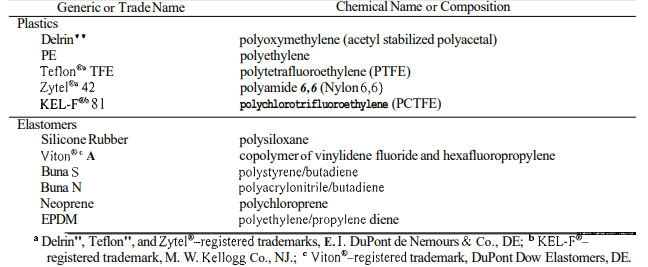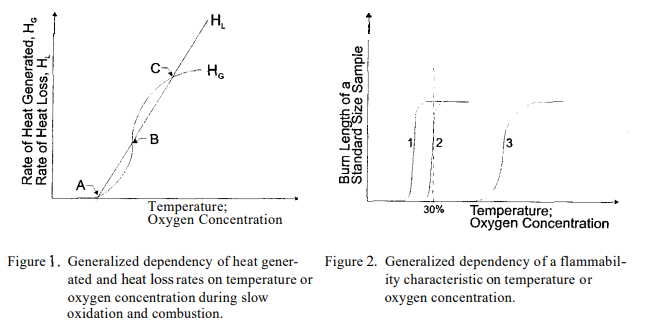Spacecraft tire safety emphasizes fire prevention, which is achieved primarily through the use of fireresistant materials. Materials selection for spacecraft is based on conventional flammability acceptance tests, along with prescribed quantity limitations and configuration control for items that are nonpass or questionable [I]. NASA STD 6001 Test 1 [2] is the major method used to evaluate flammability of materials intended for use in the habitable environments of US spacecraft. The method is an upward flame-propagation test in a quiescent environment using a well-defined igniter flame at the bottom of a vertically mounted sample. A material passes this test if the vertical bum length is less than 15.2 cm and there is no evidence oftransfer of burning debris [2]. The upward flammability test is conducted in the most severe flaming combustion environment expected in the spacecraft. Test 1 provides conservative results by sustaining materials flaming combustion in less severe environments than those in which extinguishment occurs in quiescent microgravity environments [3]. For many years this test method has provided data that have allowed the US to achieve an outstanding spacecraft fire safety record.
Although reasonable from a flammability safety point of view, NASA STD 6001 Test 1 has a few drawbacks. The test may eliminate materials that may be safe for use on spacecraft. On the positive side, it is conservative, but it may be overly conservative on occasion. Its degree of conservativeness varies for different materials and cannot be estimated from the data, since it is impossible to estimate how far a material is removed from the combustion threshold conditions. The Test I pass/fail test logic does not allow a precise quantitative comparison with other ground or microgravity materials flammability test results; therefore its use is limited, and possibilities for an in-depth theoretical analysis and realistic estimates of spacecraft fire extinguishment requirements are practically eliminated. Attempts for precise quantitative correlations between results provided by Test 1 and other ground flammability tests generally have encountered little success. Previously, a version of NASA STD 6001 Test 1 was compared with Critical Oxygen Index test results conducted with a method similar to ASTM G 125* [4]. The data indicated that if a material had a critical oxygen index of at least 35, it could be used in the Spacelab environ-ment containing 23.8% oxygen. The empirical correlation determined, based on these tests, has been later shown not to always hold [5]. The difficulty of quantifying NASA STD 600 results has been revealed in a study [6] that attempted to correlate its results with Heat Release Rate Tests, conducted according to ASTM E 1354* and the Lateral Ignition and Flame Spread Tests (LIFT), conducted per ASTM E 1321.t This study deduced that the mean upward spread velocities in the NASA tests appear to correlate inversely with the minimum heat flux for opposed flow spread and the minimum heat flux for ignition in the LIFT tests. Furthermore, the study indicates that the peak heat release determined by cone calorimetry would not predict flammability performance in the NASA test [6]. A different result was reported for three composites in a study where the upward flame spread rate and flame spread length were shown to increase with the peak heat release rate.
A different test logic is suggested to address the NASA STD Test 1 test logic impediments: one that can determine materials self-extinguishment limits. Data to support this approach are presented, including materials self-extinguishment limits under concurrent and countercurrent flowing conditions and under quiescent conditions. The new test logic will preserve the merits of the existing method by maintaining the validity of previous data and allowing its continued use.
MATERIALS
The materials evaluated are described in Table 1. Samples tested in flowing environments were 5. I cm wide by 10.2 cm long, while samples tested in quiescent environments were 6.4 cm wide by 15.2 cm long. The difference in sample dimensions was due to the different sample holder configurations. All samples had a thickness of approximately 1.5 mm.
TEST SYSTEMS
The tests in flowing environments were conducted using a Stanton Redcroft Model FTA-I Oxygen Index apparatus. The test system met the requirements of ASTM D 2863.i The apparatus was connected to gaseous nitrogen and oxygen supplies. Before entering the glass column, the test environment was mixed and analyzed for oxygen content with a paramagnetic oxygen analyzer. Tests in quiescent environments were conducted in a 1400-L flammability chamber connected to a vacuum pump with air, oxygen, and nitrogen supplies. The test system met the NASA STD 6001 Test 1 requirements.
PROCEDURES
Limiting oxygen index (LOI) testing procedures in flowing environments are described in ASTM D 2863. The downward flame propagation tests were standard. Upward flame propagation tests were conducted on vertical samples ignited at the bottom. Flammability transition testing in quiescent environments was conducted following NASA STD 6001 Test 1 procedures. The testing was conducted sequentially as recommended by ASTM D 2863, and using a step size of 1% oxygen. The upward LOIS were calculated with the “up-and-down method for small samples’’ [8]. This method has been adopted by both IS0 4589 [9] and ASTM D 2863 for determining the “minimum oxygen concentration required to support combustion of plastics.” The maximum oxygen concentration that consistently results in self-extinguishment (MOC) was the oxygen concentration at which self-extinguishment consistently occurred in the LO1 vicinity.

RESULTS AND DISCUSSION
The rates of heat generation and heat loss are predominant variables during ignition and transition to
flaming combustion. A simplified picture of the process can be obtained if the oxidation rate is assumed to he of Arrhenius type and the rate of heat loss is directly proportional with the temperature difference between the reaction zone and ambient temperature [IO] (Figure 1). Qualitatively, the system temperature on the abscissa could be replaced with another variable, such as oxygen concentration, because increasing oxygen concentration results in higher flame temperatures and increased heat transfer to the fuel caused by reduction of the flame standoff distance. This qualitative equivalency is supported, furthermore, by the observation that some major flammability characteristics, such as flame spread rates,exhibit similar trends with increasing oxygen concentrations for a large number of materials.*
In Figure I, A, B, and C are stable conditions in which the heat generated equals the heat lost. A corresponds with a slow-rate oxidation process, whereas C corresponds with a condition of stable combustion. Small random perturbations around A and Care likely to bring the system back to the same stable conditions. A small consistent perturbation for a system in B would result in a transition to A or C, depending on whether the conditions become less or more severe, for example, decreasing or increasing oxygen concentrations. The trend shown in Figure 1 is material-characteristic. A simplified dependency of a flammability characteristic, such as the bum length of a standard size sample, on oxygen concentration is shown for three materials (Figure 2). Intersection of a vertical line at a certain condition, for example 30% oxygen, with the heat generation curves provides the loci of NASA STD Test 1 testing conditions for a particular material. Under these conditions, the NASA test would fail Material 1, pass Material 3, and probably provide variable results for Material 2. Because flammability transition loci were unknown, the results would not allow flammability predictions at lower oxygen concentrations for Material I and at higher oxygen concentrations for Material 3.
Material 2 would be suspected in the transition zone, but with uncertainty because of the limited testing conducted since the NASA test requires only three samples to be tested. It can be observed that the data obtained are environment-specific rather than material-specific; consequently, they may have a limited value for predicting flammability at other conditions. Conversely, the transition zone is material-specific for a given configuration, and knowing its value allows flammability predictions in both less and more severe conditions.

The theoretical analysis above is supported by the experimental test results summarized in Tables 2
and 3. Table 2 indicates that the transition zones are very small; in other words, a small change in oxygen concentration can make the difference between self-extinguishment and sustained stable combustion.
Pressure increase from 12.4 to 14.7 psia had a small effect on the MOC of most materials. Only the MOC values for PTFE, KEL-F 81, and silicone were lowered by more than 1% absolute. The slight discrepancy between the calculated flammability limits and the self-extinguishment or stable combustion transition values shown in Tables 2 and 3 is due to the statistical method used. The calculated flammability limits are estimated statistically from the last six or seven experimental values obtained during the testing phase, which focus on the self-extinguishment or stable combustion transition zone.
Pressure increase from 12.4 to 14.7 psia had a small effect on the MOC of most materials. Only the MOC values for PTFE, KEL-F 81, and silicone were lowered by more than 1% absolute. The slight discrepancy between the calculated flammability limits and the self-extinguishment or stable combustion transition values shown in Tables 2 and 3 is due to the statistical method used. The calculated flammability limits are estimated statistically from the last six or seven experimental values obtained during the testing phase, which focus on the self-extinguishment or stable combustion transition zone.

significantly lower heat of combustion of these two materials may have played a role in this result, since the strength of buoyancy currents is directly affected by this parameter. Based on the materials response to the ignition source, all methods clearly distinguished three groups of materials. Kel-F 81 and PTFE were least flammable, followed by silicone, Zytel and Viton. Polyethylene, Bum S, neoprene, Bum N, EPDM, and Delrin were the most flammable. The flammability results were in agreement with expectations based on the chemical makeup of materials.
CONCLUSIONS AND RECOMMENDATIONS
To maintain a bridge with the existing NASA flammability data, the preferred new method is based on the NASA STD 6001 Test 1, modified for sequentiality. This improved method, compatible with the current test, will maintain the validity of previous data and allow their continued use. It will also allow concomitant determination of MOC and upward limiting oxygen index (ULOI). From a safety point of
view, the practical use of MOC is preferred, although the ULOI may be more repeatable. The overall cost for evaluating one material will slightly increase. The method is not suitable for evaluating flammability of configurational items. Further testing is needed to determine the repeatability of the method.




